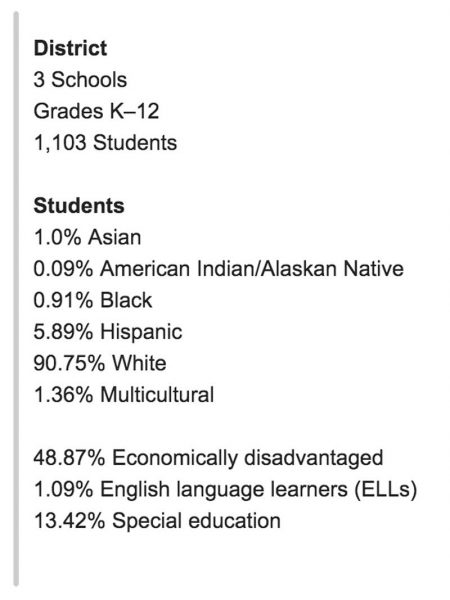Shenandoah Community School District, Shenandoah, Iowa Impact Story
Increasing Coherence and Student
Performance in Middle School Math
The Shenandoah Community School District (CSD) is located in the southwest corner of Iowa, about an hour from the Omaha metro area. The district encompasses approximately 225 square miles, and the surrounding area has a rich history in the seed and nursery business.
At Shenandoah Middle School, every student has a Chromebook, and technology is used to enrich learning inside and outside of the classroom. In summer 2017, while attending Twitter Math Camp, seventh grade math teacher Sarah Martin heard about a new middle school curriculum, 6–8 Math, authored by Illustrative Mathematics (IM). Since it was available as an Open Educational Resource (OER), she decided to give it a try in her classroom.
“I tried a few units last year to see if I liked the curriculum and I did,” said Martin. “I liked the coherence from unit to unit and the built-in instructional routines for student engagement. I also liked how it helped students understand abstract concepts with concrete, hands-on activities. I talked with the district about running with it, and we started using it this school year.”

Solutions
- 6–8 Math, authored by Illustrative Mathematics
- IM Certified professional learning
There are a number of factors that played into the district’s decision to implement the 6–8 Math curriculum. “It’s the number one rated middle school math curriculum at EdReports.org. It’s aligned to the Common Core State Standards (CCSS), and there is coherence from lesson to lesson and year to year. It’s listed as an approved teacher resource in mathematics for the Iowa Core by the Iowa Department of Education,” said Martin.
Providing tightly aligned professional learning
To prepare for the curriculum rollout in 2018–19, Shenandoah Middle School’s math teachers and principal attended two days of IM Certified professional learning in the summer. During the session, they examined the 6–8 Math curriculum architecture, explored the curriculum materials, and discussed the norms, routines, and structures. The professional learning was delivered by IM Certified Facilitators who work hand-in-hand with the curriculum authors to share a deep understanding of the mathematics and pedagogical approaches across grade levels, units, and lessons. “The Green Hills Area Education Agency brought in the IM facilitators for the training,” said Martin. “The IM facilitators took us through a lesson so we knew what the warm-up, classroom activities, and lesson synthesis were. They modeled different parts of a lesson and let us see what it could look like in the classroom. They explained the instructional routines. They also had us pretend to be the students, which was nice. It made us think about the problems and see how important it is to work them out before the kids do, since there may be multiple ways to solve a problem.”
Implementing a curriculum built on the coherence and progressions in the CCSS
6–8 Math is a problem-based curriculum for grades 6–8 that sparks meaningful discussions, encourages perseverance, and fosters the enjoyment of mathematics. It provides a consistent lesson structure, making it easy for teachers to support an aligned, coherent progression within and across units and grade levels. “6–8 Math aligns to the Iowa Core, so I don’t have to worry that I might be missing something. I can focus on the purpose of the lesson, instead of on finding an appropriate lesson to meet a standard,” said Martin. “I like the connections and consistency from unit and unit. I say to my students, ‘We’re in unit four now. This is same kind of thing we were doing in unit two. It’s just building onto it. As we go, we’re going to keep building and building.’ And they’re seeing those connections.” The 6–8 Math curriculum also aligns to both content standards and practice standards in mathematics to help students build their conceptual understanding, procedural fluency, and ability to apply these concepts and skills to novel situations. Using the curriculum, teachers are developing students’ mathematical thinking skills through questioning, discussion, and real-world contexts. “For students, there’s a nice balance between problem-based tasks and procedures,” said Martin. “It’s like a lightbulb has come on for them. Now they’re not just giving me the answer; they’re thinking about where that answer came from. Instead of just memorizing a formula, such as for the circumference of a circle, they’re seeing the steps and asking, ‘How we did we get this formula?’”
Supporting diverse learners
To support diverse learners, 6–8 Math includes built-in supports for ELLs, students with disabilities, advanced learners, and those below benchmark. In addition, extension activities are offered for any student who is ready to go deeper into grade-level content. During a presentation to the School Board in the fall of 2018, all three middle school math teachers said that they found the supports to be very helpful for students. “We all said that one of the things that most impressed us about 6–8 Math is that we don’t have to modify or change anything in the curriculum for our students with special needs, like we had to do with our past curriculum. 6–8 Math meets the needs of all students, including our higher-level students,” said Martin.
Results
Increased coherence within and across units and grade levels Improved student mastery of learning standards in math “We do standards-based grading and I’ve seen a noticeable improvement compared to previous years,” said Martin. “My students are grasping concepts more quickly. Because there’s coherence from unit to unit, I haven’t seen the dips in their scores that I used to see. I’ve seen increased scores on the same learning targets as compared to our previous math curriculum, and I’ve seen an increase in student performance overall.”
